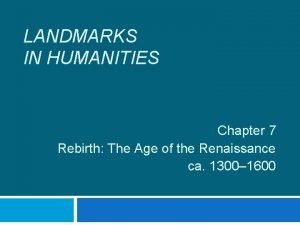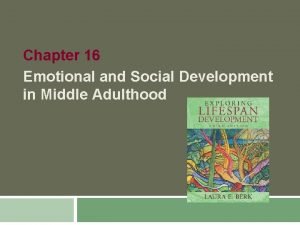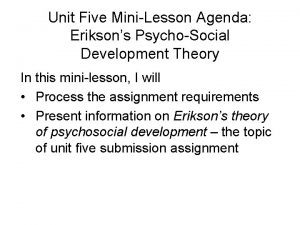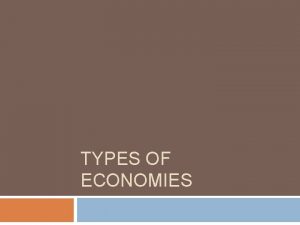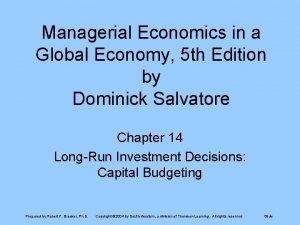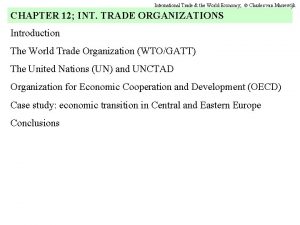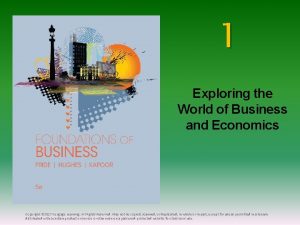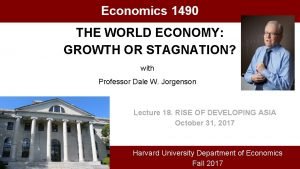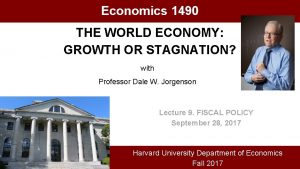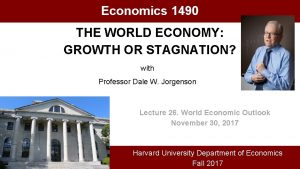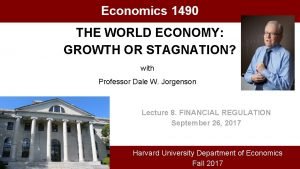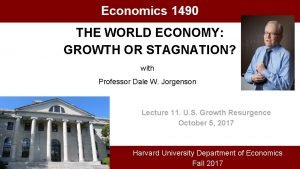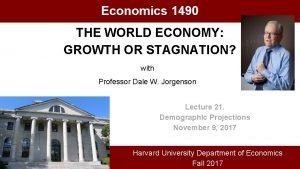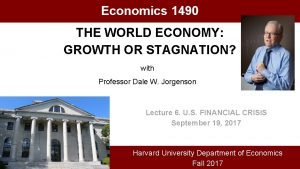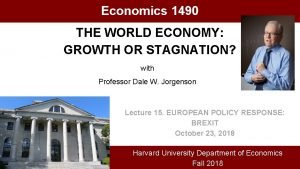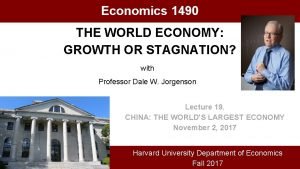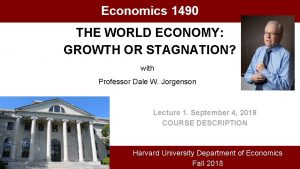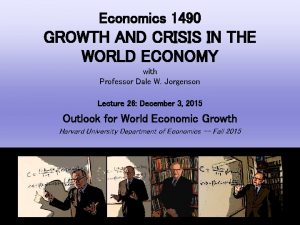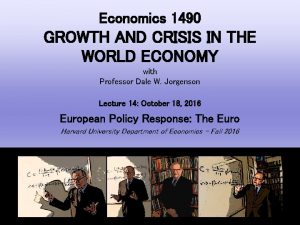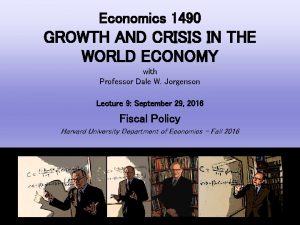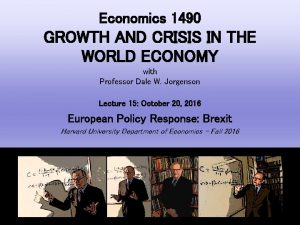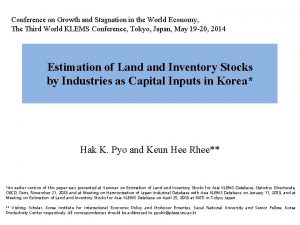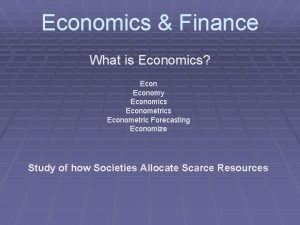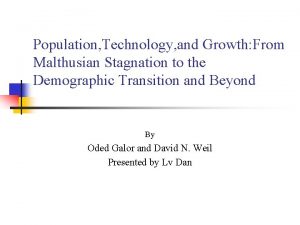Economics 1490 THE WORLD ECONOMY GROWTH OR STAGNATION
































- Slides: 32

Economics 1490 THE WORLD ECONOMY: GROWTH OR STAGNATION? with Professor Dale W. Jorgenson Lecture 16. IS ASIA’S MIRACLE A MYTH? October 24, 2017 Harvard University Department of Economics Fall 2017

THE WORLD ECONOMY: GROWTH OR STAGNATION? A. Comparing Economies B. U. S. Crisis and Recovery C. European Slowdown D. Asian Economic Miracles E. Sustainability of Economic Growth F. World Economic Outlook

D. ASIAN ECONOMIC MIRACLES 16. Is Asia’s Miracle a Myth? 17. Reviving Japanese Economic Growth 18. The Rise of Developing Asia 19. China: The World’s Largest Economy 20. India: The Most Rapidly Growing Economy

KRUGMAN: 1994, 2005, and 2013 Paul Krugman, “The Myth of Asian Miracles, ” Foreign Affairs, November-December 1994: “From the perspective of the year 2010, current projections of Asian supremacy extrapolated from recent trends may well look as silly as 1960 s-vintage forecasts of Soviet industrial supremacy did in from the perspective of the Brezhnev years. ” Paul Krugman Blog, New York Times, October 31, 2005: “[I]n the mid-1990’s I made some modestly pessimistic predictions about Asia back when everyone else was wildly optimistic. When a terrible financial crisis struck, people said I had been proved right. My response was that I had been 90 percent wrong, it’s just that everyone else had been 150 percent wrong. ”

ORIENTAL PEARL TOWER, SHANGHAI

1990 VS. 2010

KRUGMAN 1994: A SUMMARY According to the results of growth accounting, Asian economic miracles cannot persist, since they involve replication without innovation like the former Soviet Union. Advanced nations like the U. S. have achieved sustained growth in per capita income over the past 150 years by a continual increase in national income for each unit of input. Singapore is Krugman’s leading example: Economic growth involves a huge investment effort and rapid growth of the labor force, mainly by immigration. But this is far from typical of Asia. Suppose, he says, that China is like Singapore: If China’s growth is seven percent per year rather than ten percent, it will make a huge difference.

PAUL KRUGMAN 2013: HE’S BAAACK! Paul Krugman, “Hitting China’s Wall, ” New York Times, July 18, 2013: China is in big trouble. We’re not talking about some minor setback along the way, but something more fundamental. The country’s whole way of doing business, the economic system that has driven three decades of incredible growth, has reached its limits. You could say that the Chinese model is about to hit its Great Wall, and the only question now is just how bad the crash will be.

THE TYRANNY OF NUMBERS: THE ASIAN MODEL OF GROWTH • Output, Factor Accumulation, and Productivity Growth in the Four Tigers • Each of the Four Tigers Increased Labor Force Participation and Educational Attainment • Each Had a High and Rising Ratio of Investment to GDP • Productivity Growth Averaged Two Percent per Year for Hong Kong, South Korea, and Taiwan and 0. 2 Percent for Singapore, Accounting for a Quarter of Economic Growth from 1966 -1990. • Productivity Growth Is Comparable to That of OECD and Latin American Economies During the Same Period

PRODUCTIVITY AND ECONOMIC GROWTH

MEASURING PRODUCTIVITY

THE FOUR TIGERS

GROWTH RATES

INVESTMENT/GDP RATIO

TFP GROWTH: SINGAPORE, HONG KONG

TFP GROWTH: SOUTH KOREA

TFP GROWTH: TAIWAN

TFP GROWTH: AVERAGE AND COMPARATIVE

RECONCILING ESTIMATES OF PRODUCTIVITY GROWTH

PRODUCTIVITY

MEASURING CAPITAL

TYRANNY OF NUMBERS: SUMMARY AND CONCLUSION The results of this paper should be heartening to economists and policy-makers alike. If the remarkable post-war rise of East Asian living standards is the result of one-shot increases in output brought about by the rise in participation rates, investment to GDP ratios, and educational standards and intersectoral transfers from agriculture to other sectors … then economic theory is admirably well equipped to explain the East Asian experience. Neo-classical growth theory, with its emphasis on level changes in income and its well-articulated quantitative framework, can explain most of the difference between the performance of the [Asian Tigers] and other post-war economies. Alwyn Young, p. 675.

THE FOUR TIGERS: HAS ANYTHING CHANGED? • Growth of Output: World Bank International Comparison Program • Growth of Inputs: Jorgenson and Vu, The Rise of Asia • Growth of Total Factor Productivity Is the Difference between Growth of Output and Inputs • Growth Rates of the Four Tigers Have Fallen, but Rates of Productivity Growth Are About the Same

THE RISE OF ASIA AND THE NEW ECONOMIC ORDER • THE SOURCES OF ECONOMIC GROWTH: Capital Input, Labor Input, and Productivity • CAPITAL INPUT GROWTH: Information Technology and Non-Information Technology • LABOR INPUT GROWTH: Hours Worked and Labor Quality. • PRODUCTIVITY: Output per Unit of Input

CAPITAL INPUT GROWTH • INPUT SHARES OF IT: Computers, Communications Equipment, and Software • CAPITAL CONTRIBUTION BY INFORMATON TECHNOLOGY: Computers, Communications Equipment, and Software • CAPITAL CONTRIBUTION IT AND NON-IT: IT vs. Non-IT Capital Services

SOURCES OF ECONOMIC GROWTH • LABOR INPUT GROWTH: Hours Worked and Labor Quality • TOTAL FACTOR PRODUCTIVITY: Output versus Input • SOURCES OF ECONOMIC GROWTH: Capital Input, Labor Input, and TFP

SOURCES OF WORLD ECONOMIC GROWTH

SOURCES OF G 7 ECONOMIC GROWTH

SOURCES OF ASIA 7 ECONOMIC GROWTH

SOURCES OF MAJOR DEVELOPING ASIA ECONOMIC GROWTH

THE RISE OF ASIA: SUMMARY AND CONCLUSION … Our first objective is to allocate the growth of world output between input growth and productivity. Surprisingly, input growth greatly predominates. Productivity growth accounted for 14. 1 percent of world growth during 1990– 1995, while input growth accounted for the rest, as shown in Table 2. Productivity growth contributed 17. 8 percent of growth in 1995– 2000, but surged to 36. 4 percent during the worldwide boom in 2000– 2005, before plunging back to only 7. 2 percent in 2005– 2009. Jorgenson and Vu (2011)

THE ASIAN MODEL OF ECONOMIC GROWTH Just as predicted by the neo-classical model, growth rates have declined and are approaching a long-run equilibrium determined by growth of population and the Harrod-neutral productivity growth rate. Japan entered this phase around 1973; the Four Tigers entered at various times, beginning around 1980. China is about to enter this phase and India’s growth rate was still rising in 2010. We will have to address the issue of whether India will be following the Asian model outlined by Alwyn Young or will fall short through deficient factor accumulation. For this purpose we need growth accounts that are comparable to other Asian countries.
 Christopher columbus map
Christopher columbus map Where was the early renaissance (ca. 1400-1490) centered?
Where was the early renaissance (ca. 1400-1490) centered? The economy: economics for a changing world
The economy: economics for a changing world Prisoner's dilemma
Prisoner's dilemma Generativity vs stagnation
Generativity vs stagnation Blood stagnation treatment
Blood stagnation treatment Bernoulli's principle pipe flow
Bernoulli's principle pipe flow Industry vs inferiority examples
Industry vs inferiority examples Trust vs mistrust stage
Trust vs mistrust stage Autonomy versus shame
Autonomy versus shame Generativity versus stagnation.
Generativity versus stagnation. Maladaptation of identity vs role confusion
Maladaptation of identity vs role confusion Stagnation pondérale bébé
Stagnation pondérale bébé Athenian economy vs sparta economy
Athenian economy vs sparta economy Traditional economy definition economics
Traditional economy definition economics Traditional economy definition economics
Traditional economy definition economics Three types of economies
Three types of economies Economics mixed economy
Economics mixed economy Traditional economy definition economics
Traditional economy definition economics Managerial economics in a global economy
Managerial economics in a global economy School of business and economics maastricht
School of business and economics maastricht Elements of mathematical economics
Elements of mathematical economics Growth analysis
Growth analysis Primary growth and secondary growth in plants
Primary growth and secondary growth in plants Carothers equation
Carothers equation Primary growth and secondary growth in plants
Primary growth and secondary growth in plants Chapter 35 plant structure growth and development
Chapter 35 plant structure growth and development Geometric growth graph
Geometric growth graph Neoclassical growth theory vs. endogenous growth theory
Neoclassical growth theory vs. endogenous growth theory Organic growth vs inorganic growth
Organic growth vs inorganic growth Fascist corporatist economy ap world
Fascist corporatist economy ap world World-economy
World-economy Exploring the world of business and economics
Exploring the world of business and economics

